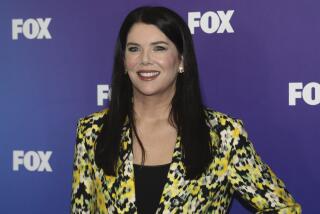YouTube’s new TV service gives it a big chance to reinvent the 30-second commercial
YouTube says its new streaming service marries the convenience of online video with the star power of broadcast and cable TV.
That applies to not just shows, but also the ads.
YouTube can sell a chunk of ads during programming, which includes live streams across any device of CBS, Fox, ESPN, AMC and more. Though small compared to the number of streaming ads sold by the channels themselves, they give YouTube considerable space to introduce new capabilities to TV commercials.
So far, those ads aren’t breaking new ground. But they have vast potential.
Take for example a big recent Bank of America ad campaign that featured social media stars offering cooking and design tips. These lifestyle gurus pitched the bank’s services in the end, but not before offering some helpful suggestions for the home.
But in the midst of binging on a show, saving those utilitarian videos for future reference isn’t top of mind — and isn’t made easy.
It’s not hard to imagine a future where YouTube could make that ad more interactive. The company could offer to stash the ad in a user’s DVR cache or remind them about it over the weekend. Or it could place a form or quiz at the end of the spot to help viewers commit to memory what they just learned.
YouTube executives say they’re emphasizing making channel surfing and watching a program feel personalized. The company accomplishes this now by tailoring suggestions of shows, movies and YouTube clips to watch. Interactive ads eventually could be another way to facilitate a customized experience.
“We’re leaning into our users, who were looking to us and saying we trust you to help us to engage with TV programming,” said Kelly Merryman, vice president of content partnerships. “We’re going to innovate on ads, we’re going to innovate on personalization.”
Dish Network, Sony’s PlayStation unit and AT&T-DirecTV are offering broadcast and cable channels through Internet connections too. Several start-ups, including Innovid, Interlude and GumGum, are experimenting with making ads two-way experiences in which users click their way through.
But none of them have the advertising pedigree and technology machinery of YouTube and its parent company, Google.
Finding new ways to appease YouTube advertisers is crucial for Google because the video unit is among its few areas showing stellar growth.
YouTube is charging $10 a month for ad-free access to the sprawling library of user-uploaded videos. It’s asking for $35 a month for its new TV service, which is aimed at people who want a cheaper alternative to the likes of Spectrum, Comcast and Cox.
The subscriptions could start better conditioning a generation of cord-cutters to pay for content they consume online. Nevertheless, media analysts still expect YouTube’s value to rise or fall based on ad sales.
For now, YouTube’s focus is on convincing consumers to sign up for its subscriptions. Los Angeles and San Francisco are among the first five regions where the TV service is available.
YouTube touts that its TV service includes unlimited DVR capabilities with recordings stored for nine months. Not all ads will be skippable though, the Wall Street Journal reported Monday.
Another key component is that users can share an account for no additional fee with up to five other people in the same home (and three people can watch simultaneously). But there’s an emphasis on the “same home” part — YouTube says it plans to track viewing locations to catch violators.
Drawbacks include no CNN, Comedy Central, PBS or the Dodgers sports network yet. YouTube officials said their initial programming goal was to offer people the top 20 shows on TV.
Gender pay gap less brutal in Los Angeles
Job search service Hired found that women in Los Angeles are asking for 17% less pay than male peers, a figure much higher than the national average of about 4%. But they’re ultimately receiving compensation offers that come out to 8% less — the lowest gap between women and men among major cities covered by Hired.
The findings come from a report issued by the San Francisco start-up last week based on data from 120,000 interview requests and job offers on its service.
The report notes that women with less than five years of experience are more likely to ask for higher salaries than men compared to women with greater experience. It’s unclear if that offers an explanation for the lower gender disparity in Los Angeles. Hired said its data doesn’t show that Los Angeles hires are less experienced than elsewhere.
In Los Angeles, the younger, tech-oriented companies that use Hired could be more willing to meet salary demands compared to Silicon Valley firms where hiring options are more plentiful.
Elsewhere on the Web
GSN Games Inc., a division of Sony and AT&T and based in Santa Monica, issued $2.5 million worth of stock options or warrants and plans to raise $22.5 million in funds, according to a regulatory filing. The company didn’t respond to a request to comment.
Long Beach music learning app developer Chromatik sold itself to tutor-finding app TeachLessons in San Diego for an undisclosed sum, according to the San Diego Union-Tribune.
Business Insider profiles Greg Baroth, who helps arrange crazy stunts and pranks — like swimming with snakes — to show off on social media.
Online media start-up Mic, which has offices in Los Angeles, received $21 million from a group of investors including Time Warner, according to Variety.
Three Southern California sports technology start-ups, including one that analyzes videos to automatically recognize moments that should be highlights, received investment from a St. Louis business mentorship program, according to L.A. Biz.
Los Angeles start-up Onward is testing an app to help people combat addictions, according to VentureBeat.
Venice start-up Dopamine Labs is helping banks and other clients make their software more addicting, according to “60 Minutes.”
In case you missed it
In the tangled ecosystem that is online advertising, nefarious websites collectively reap billions of dollars annually bilking advertisers. Many large companies wouldn’t want their ads financing distributors of misleading news, deceptive or counterfeit products, pirated movies and TV shows, or extremist groups. But that’s exactly what happens every day.
Soylent CEO Rob Rhinehart could escape penalties for his unlawful container home.
A former Snapchat employee is pressing a judge to unseal allegedly doctored usage statistics.
Last month, a handful of aerospace start-ups gathered in El Segundo to pitch their ideas to a room of curious investors and space aficionados at an event co-hosted by Aerospace Corp. and incubator Starburst Accelerator. Meet them.
The Trump administration tapped Lyft’s Los Angeles general manager for its transportation team.
Coming up
Virtual Reality Los Angeles’ spring expo takes place Friday and Saturday at the Los Angeles Convention Center. Expect to stand in lines, don headsets and experience the latest demos from start-ups and big hardware makers. Professors and entrepreneurs are scheduled to give talks throughout the days.
Twitter: @peard33







